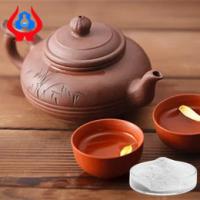| Sign In | Join Free | My himfr.com |
|
| Sign In | Join Free | My himfr.com |
|
| Ask Lasest Price | |
| Brand Name : | Linguang |
| Model Number : | C1082 C1582 C1583 C0492 C1002 C1592 CH9 CVH9 |
| Certification : | HALAL KORSHER ISO9001 HCCP ISO22000 ISO14001 |
| Price : | USD |
| Payment Terms : | L/C, D/A, D/P, T/T |
| Supply Ability : | 1.5 ten thousand per year |
| Delivery Time : | withing 15 days |
Sodium Carboxymethyl Cellulose For Ceramic Billets
CMC can be used in ceramic body, glazing pulp, and fancy glaze. Used in ceramic body, it is a good strengthening agent, which can strengthen the mouldability of mud and sand materials, facilitate body shaping and increase the folding strength of the green body. Used in glazing pulp and fancy glaze, it is a binder that plays a role of suspending, deflocculating and water holding.
Applications in glazing pulp
CMC belongs to polyelectrolytes. It worked as binder and played a
role of suspending. When CMC is added into glaze pulp, water seeped
into the gel inside, and then its hydrophilic radical combined with
water, and makes it swell. In addition, the gel inside is in the
hydration swelling conditions, while its outside forms the bound
water layer. The micelle is free in the liquid cement at the first
dissolution and due to the different and asymmetric size and form,
and regularly close up to each other through the Van der Waals
forces and then combined with water layer to form the large size
network structure, so it has the stronger adhesive capacity.
*Rheological property can be effectively adjusted under the
condition of low usage, which brings convenience for enamelling;
*Improve the binding ability of the base body, increase the
intensity of the glaze surface significantly and prevent glaze
dropping off;
*High smoothness on glaze surface and stable glazing pulp, and
reduce the pinholes of the glaze surface after burning
*Excellent performance in spreading and colloid protecting to make
the glazing pulp in a stable dispersed status;
*Enhance the surface tension of the glaze materials, prevent water
spreading into the base and increase the smoothness of the glaze;
*Avoid the body cracking and printing break in the transportation
due to the reduction of the body strength after enamelling.
The application of CMC in ceramic billets
1. It can increase the bonding strength of the billet and make the
billet easy to form;
2. Improve the flexural strength of the billet and effectively
reduce the damage rate of the billet;
3. Evenly evaporate the moisture in the billet to prevent dry
explosion and cracking.
Application of CMC in Ceramic Tile Bottom Glaze and Top Glaze
1. Keep the glaze in a stable dispersed state;
2. Improve the surface tension of glaze;
3. Slow down the diffusion of water from the glaze to the billet;
4. Increase the smoothness of the glaze surface;
5. To avoid cracking and printing breakage during the conveying process caused by a decrease in the strength of the body after glaze application;
6. Reduce pinholes on the glazed surface after sintering.
| Specification | |||||||||
| Types Items | C1082 | C1582 | C1583 | C0492 | C1002 | C1592 | CH9 | CVH9 | |
| Viscosity, mPa▪s (Brookfield 25℃ 30rpm) | 1% | 450-800 | 900-1500 | 900-1500 | 350-600 | 600-1500 | 500-1000 | >3000 | |
| 2% | 5-400 | 400-2000 | 400-900 | ||||||
| Appearance | White or slightly yellowish fibrous powder or particle | ||||||||
| SVR (Brookfield) | 1% | ≥0.85 | ≥0.90 | ||||||
| 2% | ≥0.90 | ||||||||
| Degree of Substituion(D.S) | 0.80-0.90 | ≥0.92 | ≥0.98 | ≥0.92 | |||||
| Purity(%) | According to customers request | ||||||||
| Clorides(NACL w/%) | ≤3.0 | ≤6.0 | ≤3.0 | ||||||
| Loss on drying(w/%) | ≤10.0 | ||||||||
| PH value | 6.5-8.5 | ||||||||
| Clorides(NACL w/%) | ≤0.5 | ||||||||

|




